My everyday Hokkien Noodles recipe. A great sauce. Strips of chicken. Lots of vegetables. 6 minute cook. Dinner in 20 minutes flat!

Hokkien noodles
I know that I’ve repeatedly bleated about how you can throw “any vegetables you want!” into stir fried noodles. But if speed is of the essence, and you want a good amount of vegetables in your dinner, you do actually need to think about what vegetables are quick to chop, quick to cook, won’t make your stir fry watery, and you know you can get at any grocery store.
No pre-cooking required (like broccoli). Doesn’t take 5 minutes to soften (like mushrooms). And not one of those vegetables you can’t always find (like Asian greens).
Scratch all that. Today is about convenience, speed, yet undeniable deliciousness that everybody loves.
Introducing – my everyday Hokkien Noodles!

Ingredients for Hokkien Noodles with chicken
Here’s what you need to make these hokkien noodles. There’s enough protein and vegetables in this to be a complete meal. Gotta love a one-pan dinner!
HOKKIEN NOODLES
Hokkien noodles are medium thickness yellow noodles made from wheat. Get them from the fridge if you can, rather than vac-packed varieties from the aisle. Better texture, better flavour, and less tendency to break easily when tossed in the pan.
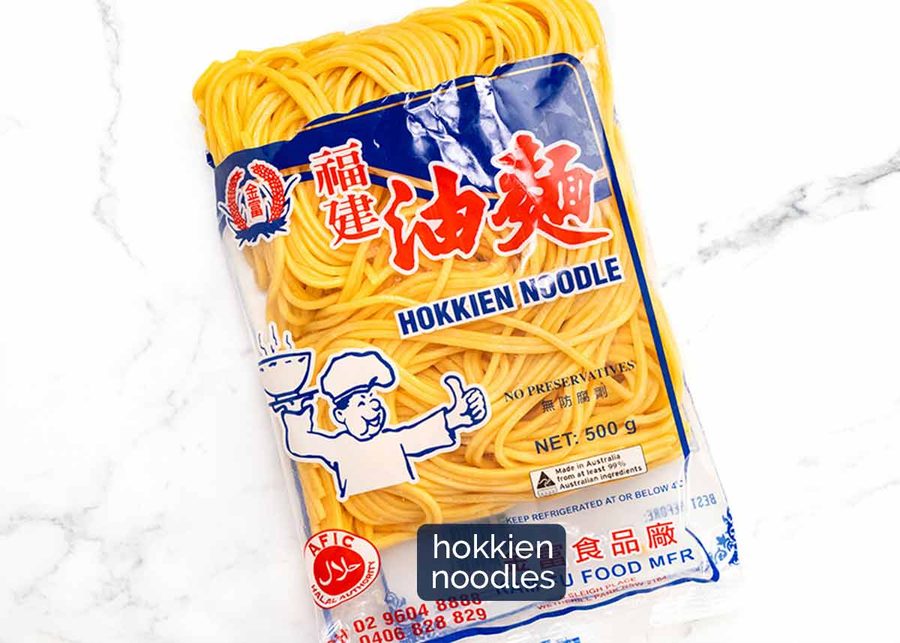
Other noodle options – This recipe can be made with pretty much any type of noodles – thin, flat, thicker, white, rice noodles, egg noodles. Or even pasta. There, I said it! Hand on heart, once tossed with the sauce, flavour-wise they are very similar though actually, noodles do have a chewier texture than pasta. 🙂
Dried noodles (like ramen, dried egg noodles, rice noodles, vermicelli noodles) can also be used but you need to use less than the weight specified in the recipe because they expand a lot more in volume when cooked. See the recipe notes for directions.
The hokkien noodle sauce
You can’t just use soy and sugar for a stir fry sauce. It’s too bland! In today’s recipe, oyster sauce is our shortcut ingredient here. It adds depth of flavour, touch of sweetness as well as thickening the sauce so we don’t even need to use cornflour/cornstarch like you typically need to.
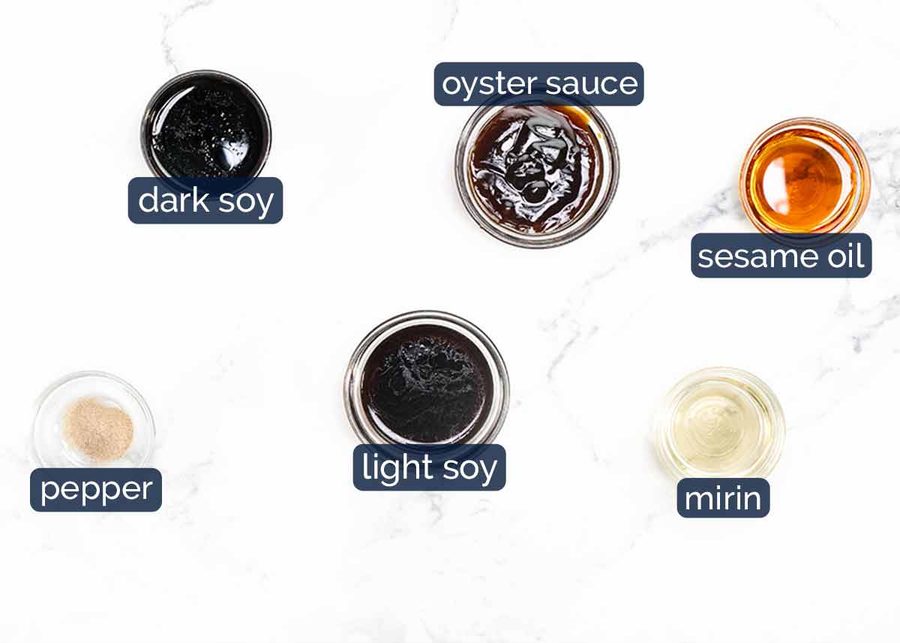
Dark and light soy sauce – We’re using a combination of both in today’s sauce because together they deliver really great flavour and colour. Dark soy sauce has a more intense flavour and stains the noodles and chicken a beautiful mahogany colour you can see in the photos. The light soy sauce adds extra salt without too much colour and the soy flavour is milder. If we only used dark soy sauce, the intense flavour would overwhelm the dish as well as it an almost black colour!
See recipe notes for how to switch each of these soy sauces out, and more on different soy sauces here.
Oyster sauce – Punches high above its weight when it comes to adding complexity, flavour and umami all at once to any dish you add a few dashes of the stuff to. It’s a staple sauce in Chinese and South-east Asian cooking made from oyster extract that is sweet, salty, thick and pungent. However it doesn’t tasty oyster-y or fishy at all once cooked. See recipe notes for substitutes.
Mirin – This is a sweet Japanese cooking wine that is the other shortcut ingredient that brings flavour to this dish. Typically in Chinese recipes you’d see Chinese cooking wine used with a touch of sugar added when needed. But today, I’m taking a shortcut by using mirin which already has sugar in it. One less ingredient needed! See recipe notes for substitutions, including non-alcoholic options.
Sesame oil – Toasted (ie brown-hued) as opposed to un-toasted (yellow-hued, with less sesame flavour). Here in Australia, toasted sesame oil is the norm. It’s actually hard to find un-toasted. Note the sesame oil is added to the sauce and not used for as frying fat, because it loses flavour the longer it’s cooked.
White pepper (or black) – Asian cooking typically uses white rather than black pepper. One of the reasons is so you don’t get unsightly black specks in clear, light brown stir fry sauces that are popular in Asian cooking. The flavour is also a little more citrusy than black pepper which is more earthy. We only use a tiny amount so you can substitute black pepper in a pinch.
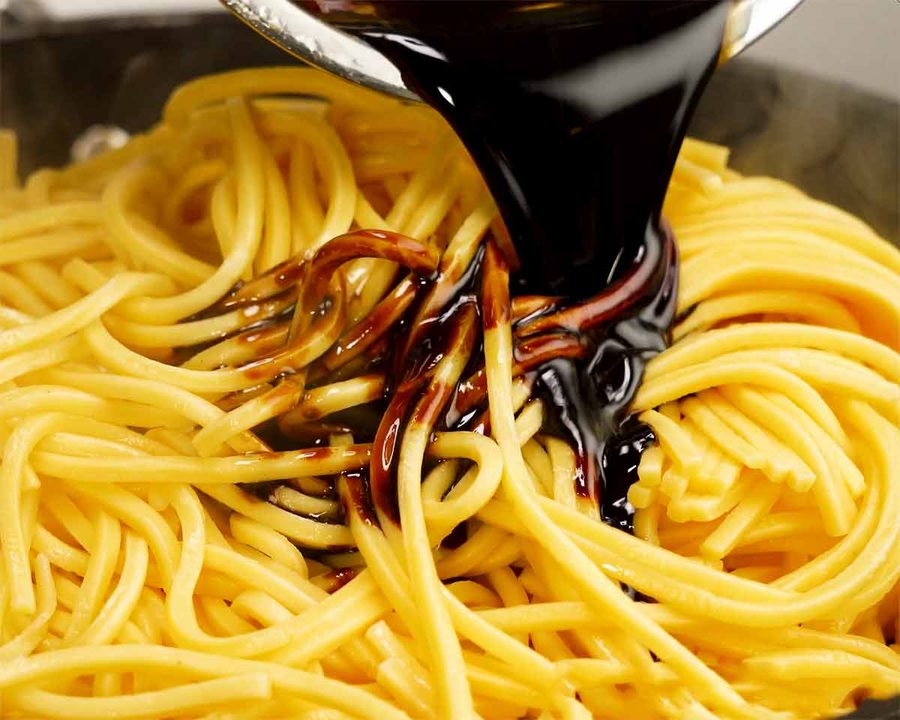
Quick cooking vegetables and chicken
Quick chop vegetables selection. Ease is the key in today’s recipe!
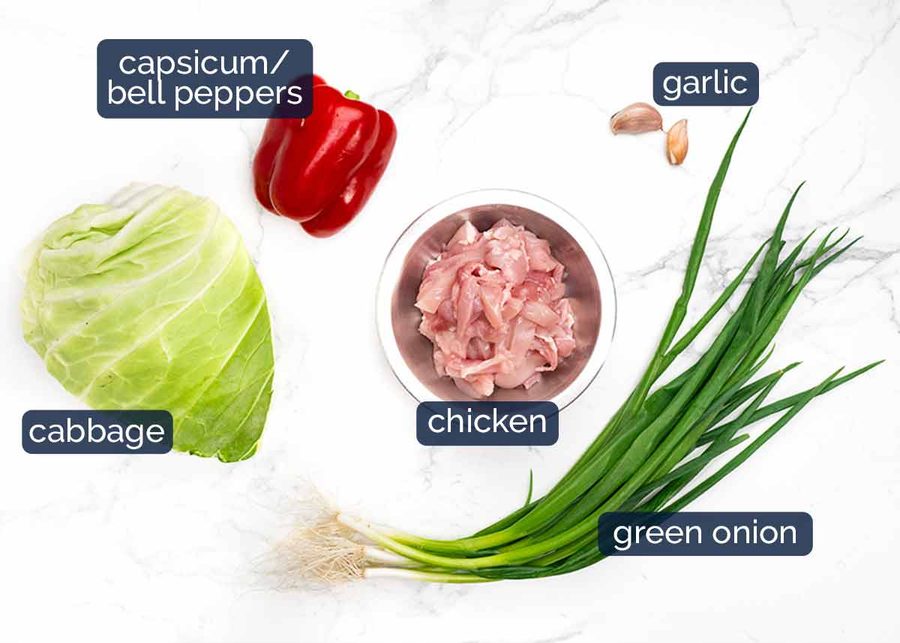
Boneless chicken thighs – I’m using thighs because they stay juicy when fried up in stir fries without having to tenderise or marinate for too long. You can switch out for chicken breast – because these noodles cook in 6 minutes flat, it won’t overcook and dry out. But, chicken thigh is juicier! 🙂 You can also substitute with more vegetables.
Green onion – Onion is a staple in stir fries because it adds fresh flavour and frying up the onion at the beginning flavours the oil. Green onion makes a good shortcut option, without the need to peel and slice! Just chop into 5cm / 2″ batons. Substitute with regular onion cut into thin wedges, but cook it before the chicken.
Note: As the softer dark green part cooks in literally a minute, we add that in at the end whereas the firmer white/pale green part (the onion-y flavoured part) is stir fried at the beginning because it takes longer to cook and also flavours the oil.
Cabbage – One of my favourite ways to add a stack of veg into a meal, fast! It’s so quick to chop up a large mound and it softens in just a few minutes in the pan. Plus, by cutting it into strips, it flops, clings and mingles nicely with the noodles. Substitute with baby spinach or tuscan kale (also cut into strips) or a couple of handfuls of bean sprouts.
Capsicum/bell pepper – I like the flavour capsicum brings to stir fries as well as a little splash of colour. And again, easy to chop – if you know the trick to avoid getting little seeds flying everywhere! You’ll see me demo it in the video. 🙂
Substitute with carrot or zucchini cut into batons.
Garlic – Finely minced with a knife is best because it disperses throughout the noodles and fries up better. However, in this recipe, you can get away with using a garlic press. But don’t talk to me about jarred garlic! (Sour. Wet. Barely resembles garlic!).
Other vegetable options – As with virtually all stir fries, feel free to substitute the vegetables with what you’ve got. Use 5 cups in total. Just add the longer cooking ones earlier and the quick cooking vegetables towards the end.

How to make Hokkien Noodles with Chicken
The sauce in today’s recipe is doing double duty as the sauce for the noodles and marinade for the chicken (just 10 minutes marinating time). So get the sauce and chicken done first, then move onto preparing the rest of the recipe.
1. Noodle sauce & marinated chicken

Mix the sauce ingredients in a bowl.
Marinate chicken – Measure out 1 1/2 tablespoons of sauce and toss with the chicken. Set aside for 10 minutes while you prepare the other ingredients and soak the noodles. It only needs a short time because the chicken pieces are so thin and the sauce flavour is quite intense.
2. Prepare noodles

Prepare noodles per the packet directions. Usually they will say to soak for a few minutes in a large bowl of boiling water, such as the one I’m using. Some brands call to be boiled for a couple of minutes. Then drain in a colander.
Rinse (💡pro tip!) – Whatever the method, rinse the noodles under the tap water briefly to remove excess starch which can make the surface of the noodles unpleasantly gummy once cooked with the sauce. It’s not a problem that happens with all brands of noodles and it depends how you prepare it, but it’s just good practice to do it so you never experience this problem.
Rinsing also prevents the noodles from hardening into a block as they sit in the colander before tossing into the pan.
3. Noodle sauce & marinated chicken

Cook chicken – In a large non-stick pan (mine is 30cm/12″) or very large wok*, heat the oil over high heat until very hot. Then add the chicken and cook 1 minute. Add the garlic and white part of the green onion stems and cook for another 1 minute until the surface of the chicken is sealed (but still a bit raw inside).
Vegetables – Add the capsicum and cabbage, then toss for 2 minutes or until the cabbage is mostly wilted. By this time, the chicken should be cooked through. If not, keep going as the chicken won’t cook much more in the next steps.
* This is quite a big batch recipe to try to make in a wok. You run the risk of the chicken and vegetables getting watery because of the smaller surface area in contact with heat, unless you use a very large one with a very large burner. It is safer to use a very large pan.

Noodles and sauce – Add the green part of the green onions, noodles then sauce. Toss for 1 1/2 to 2 minutes or until the sauce stains the noodles a lovely brown colour. Using two wooden spoons will make your life easier here (tongs break the noodles).
Finished noodles – Then that’s it! Ready to eat. So fast. How good is that!

Between transient living situations*, changes within my team, an increasingly high maintenance dog well into his senior years* and a workload that never seems to ease, I’ve been making these noodles regularly in recent months. It’s not just the speed, but also because cabbage, green onion and some type of noodles are pantry staples in my world. The capsicum is easily substituted with another vegetable (carrot, zucchini etc). Chicken is optional (I often use more vegetables). And the sauce is made with a mix of my absolute bare minimum Asian sauce essentials.
You can’t beat Hokkien Noodles freshly made, steaming, shiny and slippery. But honestly, they are still really great for one, two, three days afterwards with just a quick microwave reheat, and they freeze well too.
I hope you enjoy them! – Nagi x
* Not complaining about either of these! I know I’m fortunate to have a roof over my head, full stop. As for the other? My greatest company asset. 🐶❤️
Watch how to make it
Hungry for more? Subscribe to my newsletter and follow along on Facebook, Pinterest and Instagram for all of the latest updates.
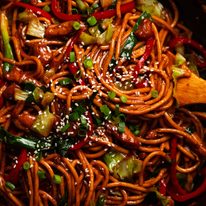
Hokkien noodles with chicken
Ingredients
- 500g/ 1 lb hokkien noodles , (fridge best) (Note 1)
- 350g/ 12 oz chicken thighs (boneless, skinless), cut into lot of thin 0.5 x 3cm / 0.2 x 1.2" pieces (Note 2)
- 2 tbsp canola oil (or vegetable, cottonseed, peanut oil)
- 2 garlic cloves , finely minced
- 8 green onion stems , cut into 5cm / 2″ lengths, white part separated from green part (Note 3)
- 1 red capsicum (bell peppers) , cut into thin 0.5cm / 0.2″ strips
- 3 heaped cups green cabbage , cut into thin 1 x 5cm / 0.5 x 2" strips
Sauce:
- 2 tbsp light soy sauce (Note 4)
- 1 1/2 tbsp dark soy sauce (Note 4)
- 2 tbsp oyster sauce (Note 5)
- 1 tbsp Mirin or Chinese cooking wine (Note 6)
- 1 tbsp sesame oil , toasted (Note 7)
- 1/8 tsp white pepper (sub black pepper)
Optional garnishes
- White sesame seeds
- Finely sliced green onion
Instructions
Abbreviated recipe:
- Marinate chicken with 1 1/2 tbsp Sauce. Cook chicken 1 min, add garlic and white part of green onion, cook 1 min. Add capsicum & cabbage, cook 2 min. Add green part of green onion, noodles, sauce, toss 2 min. Serve!
Full recipe:
- Sauce – Mix the sauce in a small bowl.
- Briefly marinate chicken – Toss the chicken with 1 1/2 tbsp of the Sauce. Marinate for 10 minutes while you prepare the noodles and vegetables.
- Rinse noodles – Prepare the noodles per the packet directions (soak in boiling water or briefly boil). Drain in a colander then rinse briefly under tap water (Note 8)
- Sear chicken – Heat the oil in a large non-stick pan over high heat until very hot (mine is 30cm/12", Note 9 re: wok). Add the chicken and toss for 1 minute. Add the garlic and white part of the green onion, then toss for another 1 minute or until the surface of the chicken is sealed (but still a bit raw inside)
- Cook veg & noodles – Add the capsicum and cabbage. Toss for 2 minutes until the cabbage is mostly wilted. Add the green part of the green onions, noodles and sauce. Toss for 1 1/2 to 2 minutes until the noodles are stained a lovely mahogany colour.
- Serve immediately, sprinkled with sesame seeds and green onion if desired!
Recipe Notes:
- Noodles – See below
- Chicken – 2 heaped cups extra vegetables
- Green onion – Finely sliced regular onion, cook before adding the chicken.
- Cabbage – Sliced Tuscan kale, Chinese cabbage (wombok), baby spinach, bean sprouts
- Capsicum – Carrot or zucchini batons, thin asparagus, broccolini cut into thin batons, snow peas cut on diagonal.
1. Noodles – Hokkien noodles from the fridge are better than the vac pack ones from the aisle. Use the same amount of other fresh noodles from the fridge, or 350g / 12oz any dried noodles or 250g/8oz dried vermicelli. 2. Chicken – Thigh is best as it stays juicier, however, breast or tenderloin can be used too. Lean pork would also be great. For beef, use any steak but I recommend velveting it so it stays tender and juicy (thin strips of beef will overcook in less than 2 minutes). 3. Green onion stems – The firmer white/pale green part takes longer to cook (like onions) so add it first, whereas the soft dark green part wilts quickly so add it at the end. 4. Soy sauce – You can substitute the light soy with all purpose soy, and dark soy with more light soy (but noodles won’t stain dark). Don’t substitute the light soy with more dark soy (too intense, will overpower dish). More on different soy sauces here. 5. Oyster sauce – Adds sweetness, depth of flavour and thickens sauce. Vegetarian oyster sauce can be used, or hoisin sauce (adds lovely hint of five spice). 6. Mirin adds depth of flavour and touch of sweet into this otherwise simple sauce. Chinese cooking wine is an excellent sub, followed by cooking sake or dry sherry. Non alcoholic – add 1/3 cup chicken stock into the sauce and toss for extra minute or two. 7. Toasted sesame oil is brown (default in Australia). Untoasted is yellow and doesn’t taste as sesame-y. 8. Rinsing noodles removes excess starch so the noodles are slippery once tossed with sauce. If you don’t rinse, sometimes the surface is gummy. Also prevents from sticking together in colander while waiting to be used. 9. Wok v pan – This is quite a big batch recipe to try to make in a wok. You run the risk of the chicken and vegetables getting watery because of the smaller surface area in contact with heat, unless you use a very large one with a very large burner. It is safer to use a very large pan. Leftovers will keep for 3 days in the fridge, I just reheat in the microwave. It actually freezes pretty well too (not rice noodles though, they have a tendency to break once frozen). Nutrition per serving.
Nutrition Information:
My noodle life
I’m a noodle-crazed lady, and I make no apologies for it!
Life of Dozer
Who here is surprised that I bake for Dozer’s vet? 😂
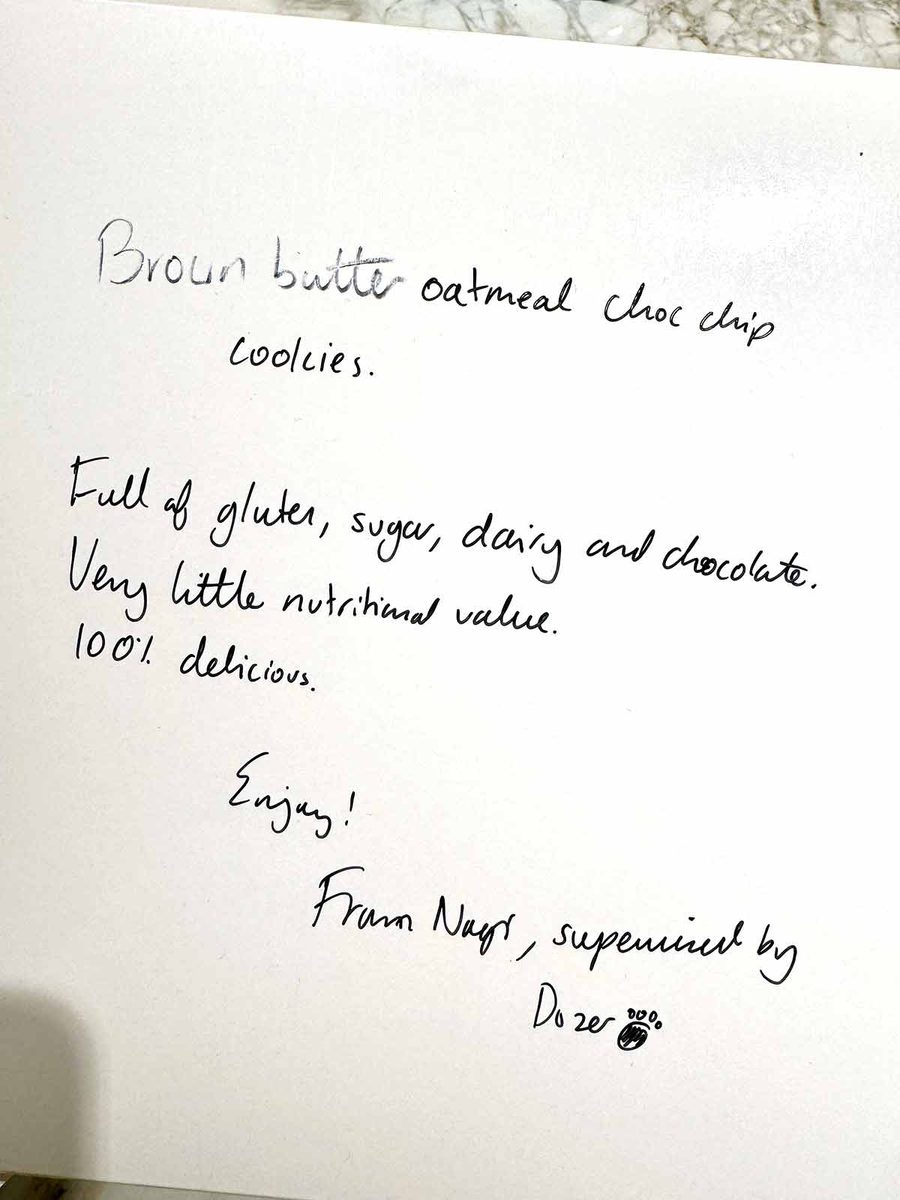

Took him in for check ups and treatment of on-going seniors problems, including his funky joints and early sign of age related spinal issues.
Here he is at the magic dog doctor, Neil Barnsley of Holistic Animal Therapies. It takes over an hour to drive there but I’ve been taking Dozer for the last 8 years – because he’s that good, and I have so much faith and trust in him. He treats Dozer for muscle, bone and joint related issues, of which there have been many over the years because he was such an active dog in his youth!

And here he is at our local vet, Gladesville Vetinary Hospital, where I took him in for vaccinations and a check up. Got the all clear – yay!

Lordy, this dog is getting high maintenance in his senior years.
Lucky I kinda love him.
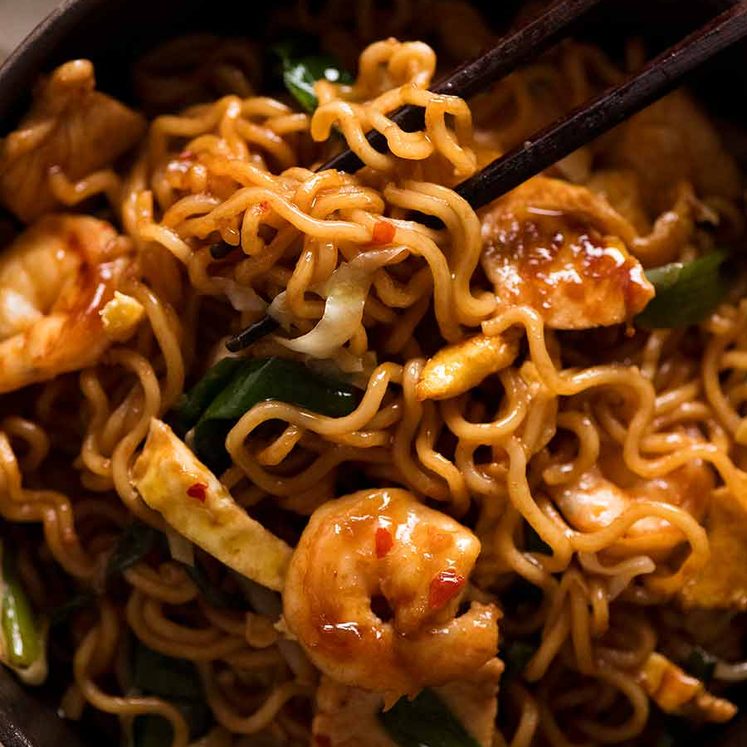
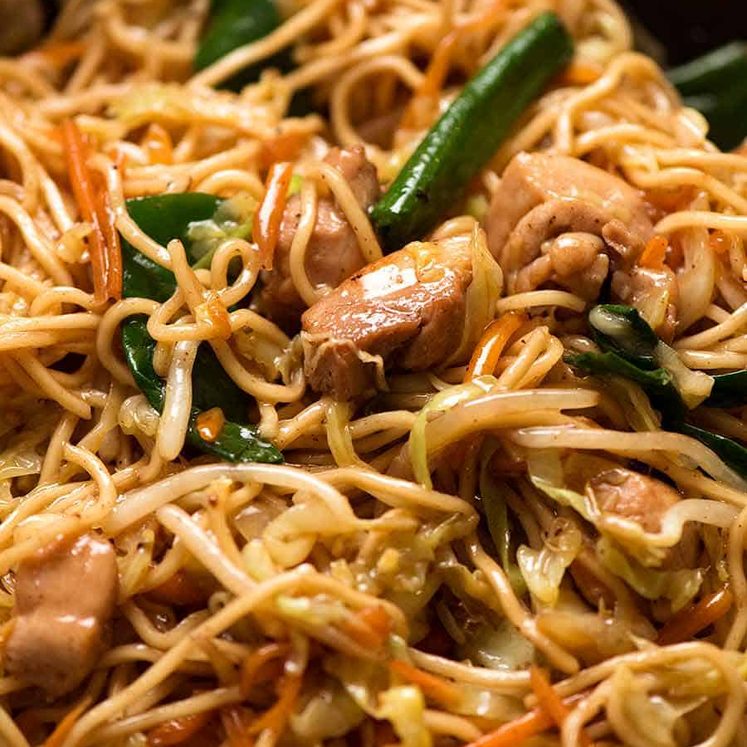
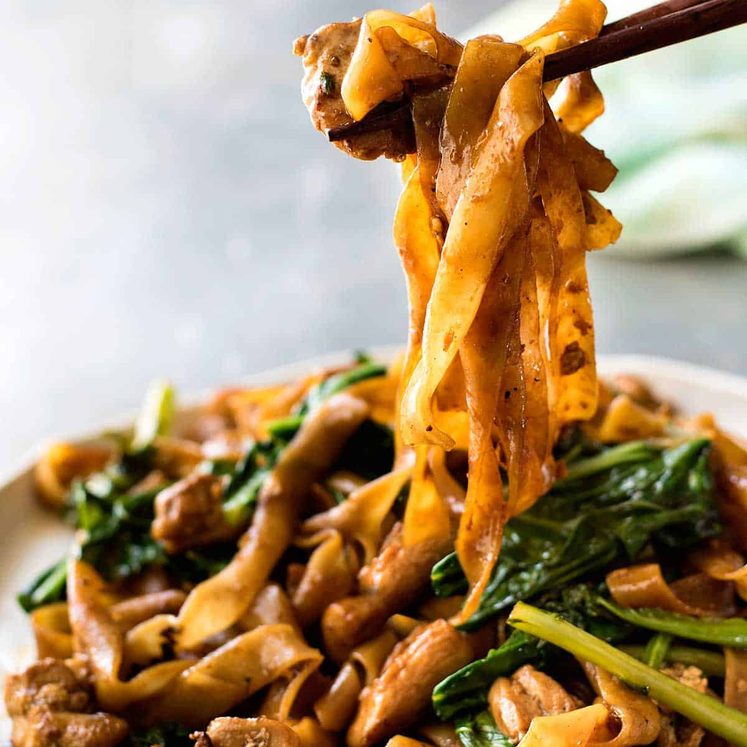
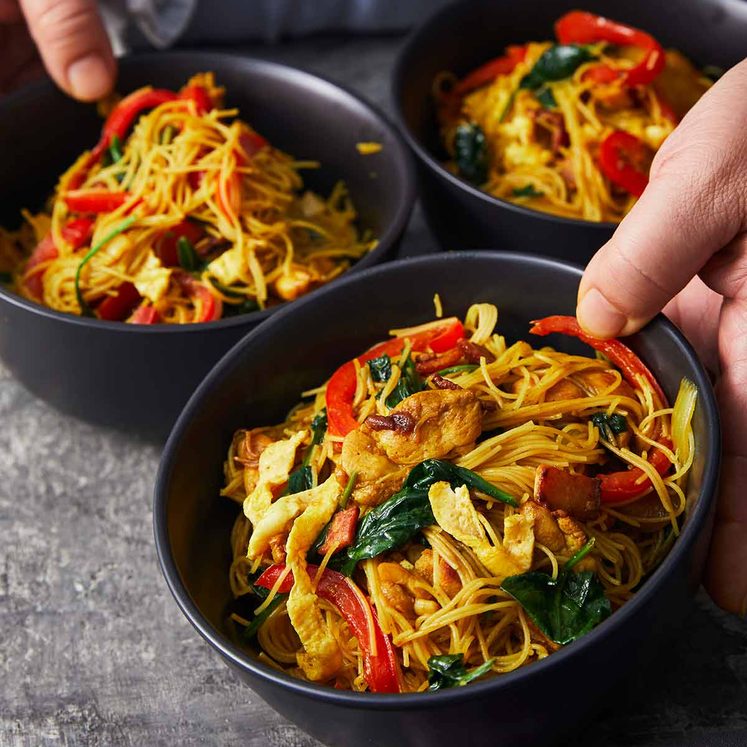
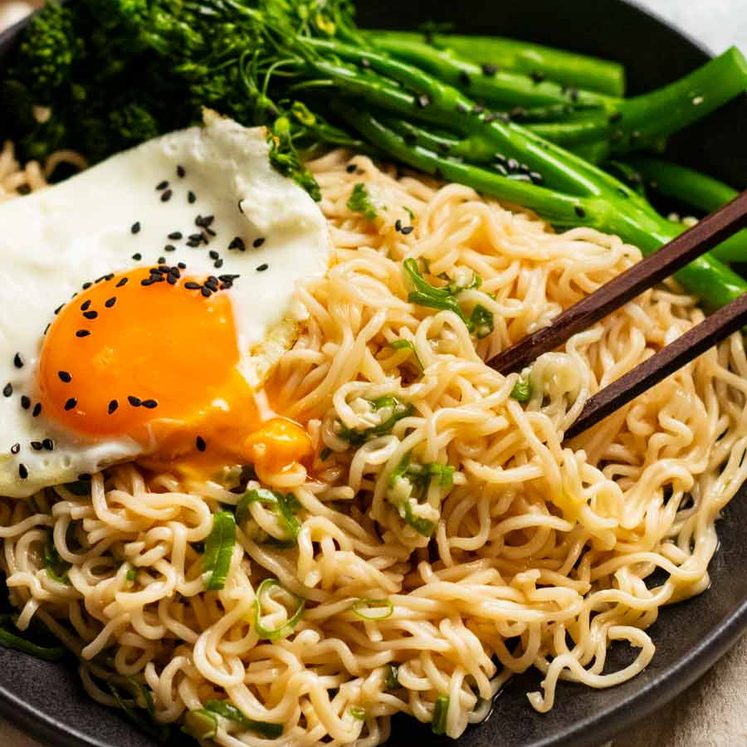
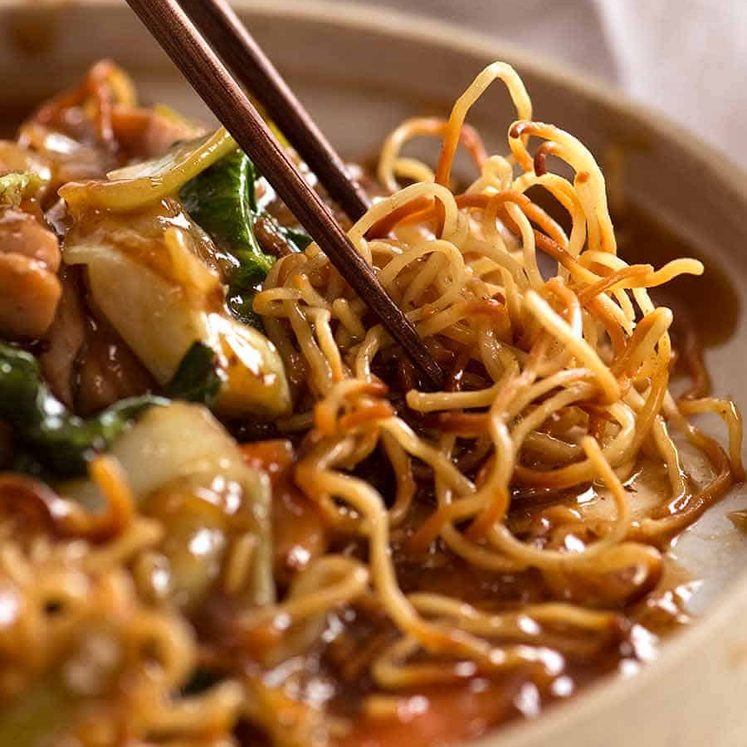
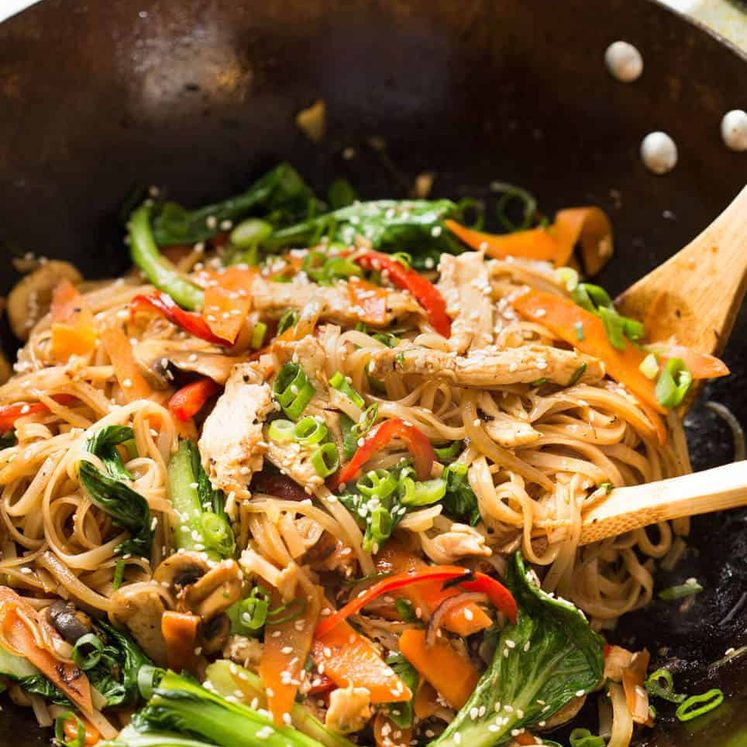
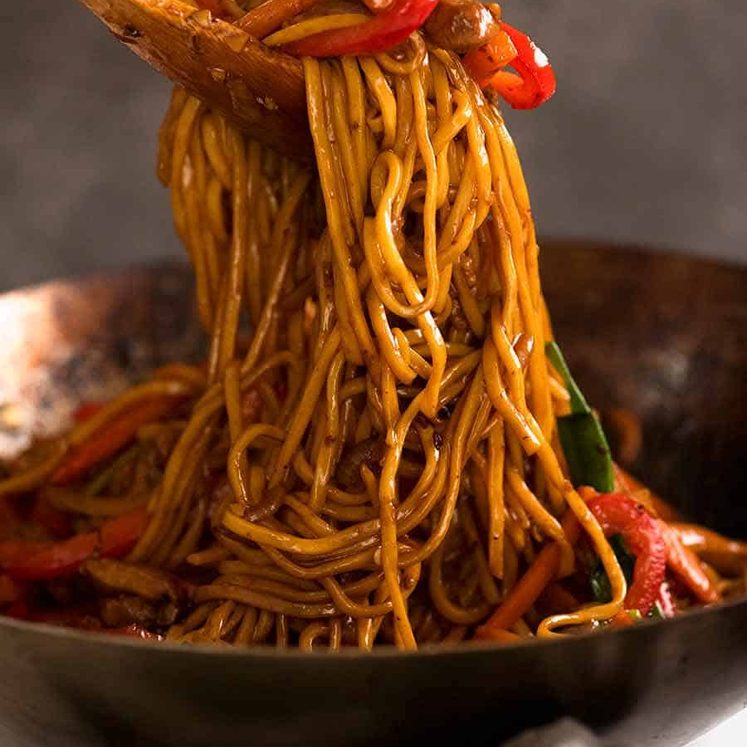
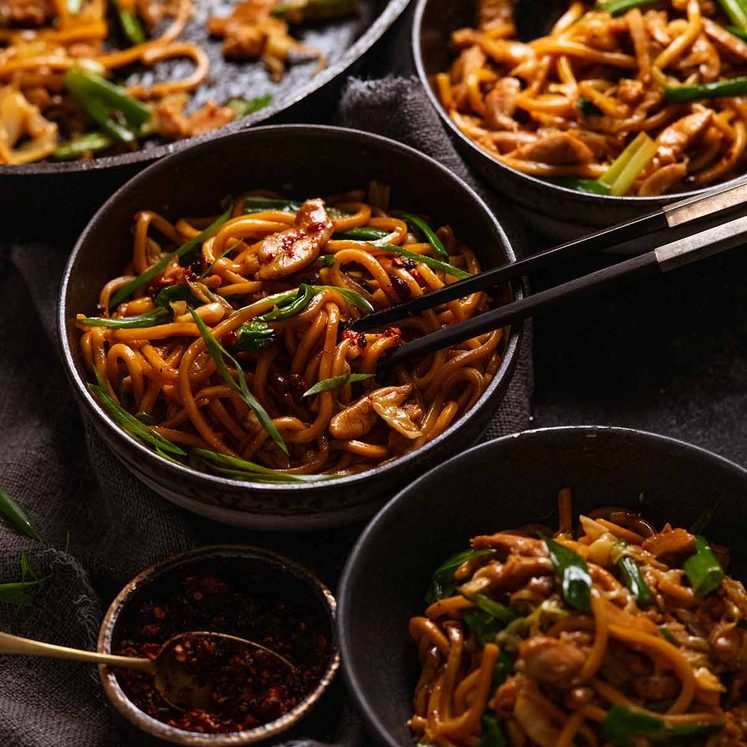
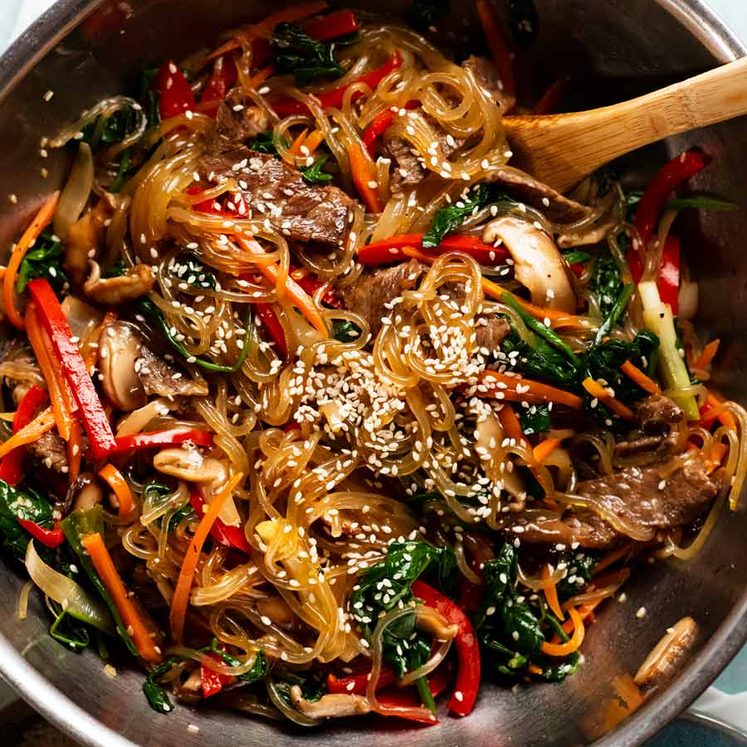
My god seriously the best hooking noodle I have ever made! It could just be or it could be Nagi, who could know. But the proportions are about right, I used slightly less dark soy as it’s a bit overpowering but awesome recipe. Thanks Nagi!!
Na, it’s 100% you Zac! 😉
I got interested in this because of the dark soy sauce. Many people eating the American Diet don’t know it’s different than typical soy sauce. It’s often found in Asian markets, but maybe not labeled as such. When you tilt the bottle sideways then return to vertical, dark soy sauce is much thicker and will coat the neck of the bottle. Regular soy sauce (by any name) will quickly run down the bottle neck.
I couldn’t find Hokkein noodles, but “more chewy than pasta” helped! I got some fresh stir-fry noodles in the fridge section, and they worked great. And the tip to always rinse Asian noodles was right on! I did that, and the noodles became my new favorite.
I marinaded the thighs about half an hour, while making other things, and that got me some very nice, super tender chicken! When it was all done, I felt there should be something more — something sweet.
I put in a couple of squirts of Hoisin sauce, and that did the trick. Then, just before serving, I saw that the sauce was very thin. There wasn’t a whole lot at the bottom of the pan, with the noodles taking in a lot, but enough.
So I put in a bit of cornstarch and water, to thicken. And that was perfect! I may (possibly) add a bit of pineapple tidbits next time.
We’re old folks, and green cabbage “wilted” is just too much for the old teeth. I’d thought about using Napa cabbage, but found some young Bok Choy while shopping. Those were superb! I did pre-cook them a little in the microwave, but the leaves gave that “cabbage” effect, and the young stalks just helped overall.
I totally like the marinade /sauce recipe, and that goes into the rotation now. Thanks for all your work on this blog. 🙂
Thanks for your comprehensive feedback Craig! 🙂 So glad you enjoyed the marinade – N x
Nagi the second I saw this one on Insta I knew I had to make it this week. I replaced hokkien noodles with spaghetti and used whatever veges I had in the fridge. Whole fam loved it. It’s going down as a weekly favourite and I’ve decided you’re one of my fav people in this world.
Aww Suz! What a lovely message to wake up to 🙂 N x
Made this tonight and it was a triumph of taste!
Didn’t get the colour right but the taste was yum!
I used left over pak choy instead of cabbage, chinese cooking wine instead of mirin and dried egg noodles instead of hokkien.
Heck I even used frozen capsicum and crushed garlic from a jar!
Thank you Nagi!
So tasty, quick and easy!
My 8 year old enjoyed it too.
Your recipes are so easy to follow and produce such delicious food. Thank you!
This recipe is a miracle!! Was so fast to make 🙂 I made crispy tofu to accompany. And I topped it with sliced almonds. Delicious – thank you Nagi! Xoxo
Made this for dinner last night. Not sure why, but I didn’t get the deep, rich color that you do. My noodles looked anemic – very pale, even though I followed the recipe exactly I don’t really care for the slipperiness of Hokkien noodles, so if I make it again, I’ll sub a sturdier noodle. I’ll also beef up the sauce to make the flavor more intense. I ‘d like to try this with velvetized chicken breasts.
Hi Brian! Are you sure you used dark soy sauce? Because that has such an intense colour, this is what stains the noodles! N xx
Hi Nagi 💕 I’m in the same boat as Brian unfortunately – nowhere near enough deep brown sauce color despite following the exact ingredients. Can the sauce be doubled or tripled to achieve your video effect?
Hello Kate! Are you sure you are using dark soy sauce? The label says as such? Because proper dark soy sauce stains anything it touches with just a tiny amount! I wish I could get a photo of your bottle! – N x
Yes, I used “double black” which I assume is the dark variety. I beefed up the leftovers with more oyster sauce which gave it much more flavor!
Delicious and so versatile. Great way to use those small pieces of veg in frig. Chicken + finely sliced red onion & brussels sprouts, mixed mushrooms & English spinach. The sauce is excellent – the right balance of flavours.
Yum yum yum! Funny, I’m about to make a fourth recipe of yours since yesterday… Lol. Just had these noodles for lunch and I’ll make the vegetarian gyoza shortly.
I used the fresh hong Kong style noodles, because that’s what I had. Instead of chicken, I pressed extra firm tofu, then marinated it. Added lots of oyster mushrooms, bean sprouts and extra veggies, and double the garlic, green onions, and sauce, making it in a big skillet as well as wok since it was too much to fit in one pan. The veggies just disappeared into it so well that my mom steamed extra broccoli on this side 😆. Thank you for another fantastic recipe!
PS Your cookbook is gorgeous! I got it, but I’m so used to using the website, I still have not used the physical book as yet 😂
I love all your recipes but this is so easy and quick. There was second and third helpings from my grandsons. 🙂
Delivers on taste and ease of delivery. Such a quick and tasty meal- love it. Hubby went back for seconds and literally hoovered it. Lol
I made this tonight for the family and got rave reviews. I subbed Chinese cooking wine for the mirin and added carrots with the peppers and cabbage. Super tasty! Because I sliced the veggies into small slices/batons as you suggested, they mixed well with the noodles and sauce, and kind of disguised them so I didn’t have any leftover veggies on the kids’ plates. Yay!
My husband and I LOVE your recipes and he can’t wait till your cookbook arrives here. I made this tonight and we were kind of in a hurry to eat and then to get to a meeting. He took one bite, laid his fork down and said “This—— is delicious.” I couldn’t agree more!
I’m so glad you got rave reviews from your husband!!! Thank you for getting my cookbook, I hope you both love it. I’m counting down the days too! N x
I cooked this and replaced half the noodles with beensprouts and added chillies for heat! Delicious. Definitely do this regularly. Thanks Nagi.
That’s terrific to hear James! So glad you enjoyed it – N x
Hi Nagi. Could you let me know how long the Chinese wine lasts in the fridge once opened ? Thanks 😀
Hi Amanda! Years and years and years 🙂 At least 2!
When I told my partner I was making this for dinner he wasn’t too keen but he ended up inhaling it and asking for seconds. Now we have no leftovers for tomorrow. I added 2 tablespoons of chilli crisp oil to the sauce at the beginning and it gave it some nice heat. Absolutely delicious!
So so tasty and very quick to make thank you
Glad you enjoyed it Annette!
Hey Nagi, can I add brown sugar to make it sweeter or will it not work with the flavours?
Oops – forgot to rate it.
I made this for dinner tonight and both my husband and I loved it. I used a yellow bell pepper and broccoli instead of the red pepper and cabbage. The sauce is out of this world! Thank you so much for sharing this recipe. I’ve never made one of yours that I didn’t love. Quick question – My mirin has 12.5% alcohol. Should it be refrigerated? I just opened it today.
Colurful choices! Glad you and your husband enjoyed this Karen 🙂 I keep my mirin in the pantry. Always have! N x